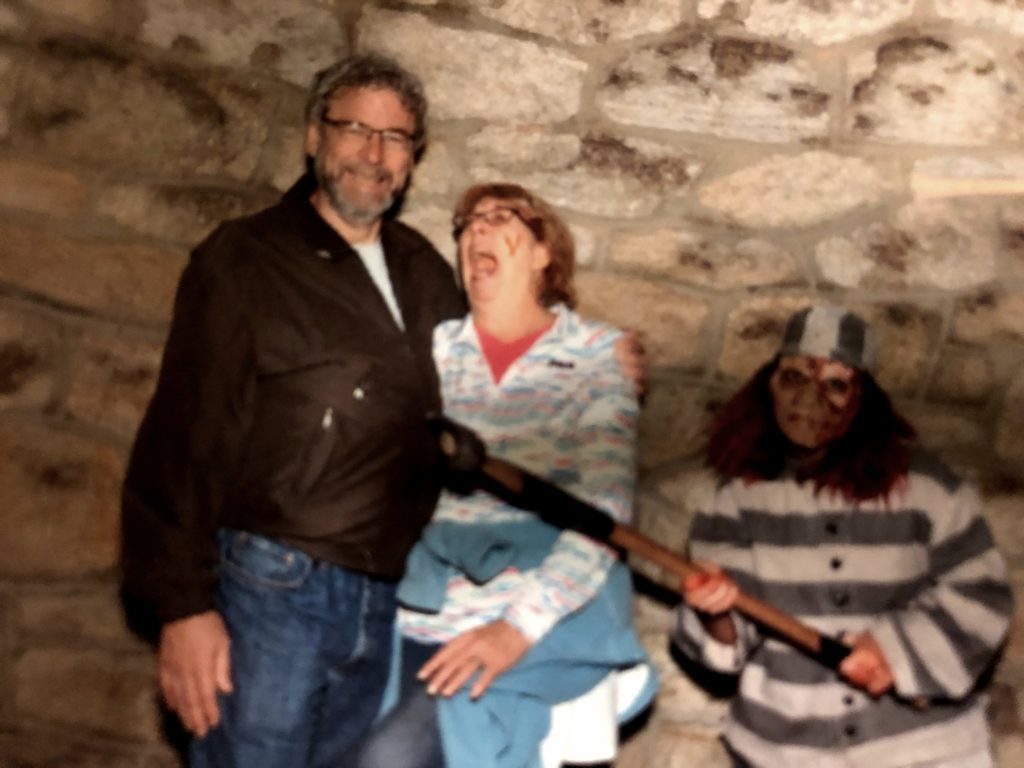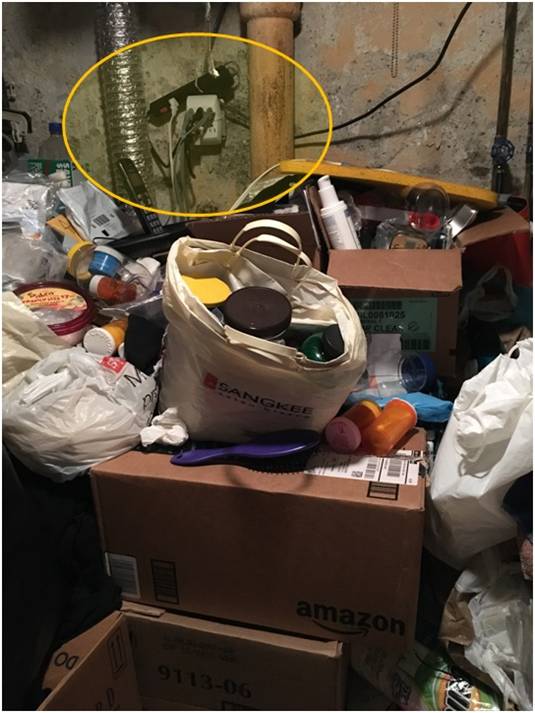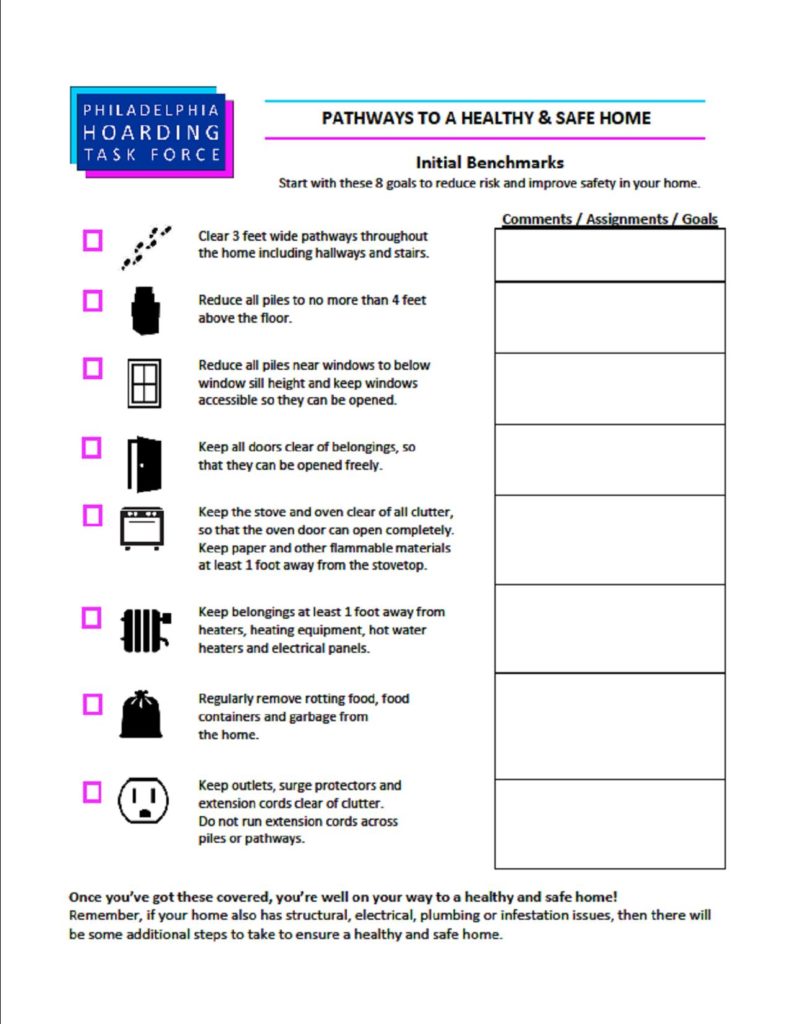Halloween is my favorite holiday. I especially love to get dressed up for an all-out costume party. My best costume, of all time, was Ms. Bald America. I wore my Senior Prom gown, elbow length blue suede gloves, a tiara, a Ms. Bald America sash and of course a bald wig. I blacked out a couple of teeth for an even more glamorous effect.
My other favorite part of Halloween is going to a truly scary haunted house. The very best one is Terror Behind the Walls at the Eastern State Penitentiary in Philadelphia. https://easternstate.org/

How does this topic tie into home organizing? Some of the scenes we walk into are scary; especially in situations involving hoarders! My worst fear is seeing something move. So far, so good. Our clients are scared too. Before we start to work with them, they are fearful and anxious about tackling cluttered spaces in their present home or office. They often become immobilized by their feeling of being overwhelmed. If they are moving, they are often scared of discarding something they “might” need or scared of the many unknowns associated with moving and selling their home.
As a professional Home Organizer I tell every client the same thing during our initial conversation; “My goal as your Home Organizer is to take as much stress out of your situation as possible.” When we are finished, I ask them “How did you feel before we worked together?” They invariably respond “I felt stressed and overwhelmed.” Then I ask them “How do you feel now?” You know the answer, “I feel like a weight has been lifted off my shoulders. I feel less stressed and more in control.”
What a wonderful role we play in our clients’ lives. What a rewarding career and sense of purpose. We restore order from chaos while eliminate fear and anxiety. We keep seniors safe and give their families peace of mind.
It’s fun to be scared in a haunted house at Halloween, but no one should be scared of their clutter.
As autumn approaches, mice look for warm homes with food and water in which to hunker down for the winter. Don’t let one of those homes be yours! At a recent NAPO-GPC* meeting, pest expert Dr. Dion Lerman shared tips on how to prevent, eliminate and clean up after those little rodents. Here are answers to questions you might not have known you had:
Are mice a health concern?
How do the rascals get in?
Where in the house do the critters live?
How can one prevent them from coming in?
What’s the best way to get rid of mice?
What’s the best way to safely clean up after the critters?
As with most things in life, an ounce of prevention is worth a pound of cure.

There are a staggering number of people in the U.S. suffering from hoarding behavior. Individuals engage in excessive accumulating or have difficulty letting go of items, sometimes so severe that it interferes with normal activities of daily life. Rooms are no longer usable for their intended purpose, we see dining rooms cluttered with belongings not meals or tubs holding clothes not bathwater. Statistics estimate that 15 million people are dealing with this issue. In Philadelphia, the estimate is 31,000 -77,000.
A cleanout is the method most municipalities use to deal with hoarding. Reducing the volume of clutter to safer levels is thought to alleviate the problem and support the person. The reality is, without treatment and support for the individual, the rate of recidivism after a cleanout is nearly 100%. With the high cost of cleanouts and low rate of return, cities are beginning to pay attention to research findings.
Thanks to the research of doctors Frost, Steketee, Tompkin and Tolin, we are now understanding that cleanouts are “stuff-centered” and don’t address the issues buried below the surface. Simply removing clutter without addressing the underlying issues illuminates the reasons for high recidivism rates after cleanouts. This research is stimulating new intervention models. Being “people-centered” is the common theme. They each involve the person with hoarding behavior as key to the solution. Given that 92% of individuals diagnosed with Hoarding Disorder also have another co-occurring disorder, there is no one set solution.
The work is personalized and takes keen listening skills, creativity, flexibility, patience, and lots of compassion. Instead of focusing solely on the volume of clutter, a spotlight shines on the safety and well-being of the individual while working to reframe old thoughts and beliefs to reduce the dependence on acquiring and saving. There is no magic pill. Everyone involved understands this disorder has deep roots; the process takes time and relapses are as common as seen with over eating or drinking.

One of the new models is Harm Reduction (HR). Its goal is to reduce the risks associated with hoarding. Instead of talking about the “stuff” to get rid of, it asks the question, “How do we keep you safe in your home and maintain clear access for emergency staff and equipment if the need ever arises?” The (HR) process provides a support person that works with the individual identifying key health and safety concerns in the home. They also serve to document goals to alleviate the issues. From this information, they design and implement a strategy to address these issues over time.
One such organization that has adopted this (HR) model is the Philadelphia Hoarding Task Force (PHTF). The Task Force is a coalition of organizations that seek to improve outcomes for people who hoard while balancing the rights of the individual with the health and safety needs of the community. PHTF is introducing service providers to this model as a way to circumvent the costly and catastrophic consequences often seen with cleanouts and instead, create favorable long lasting results.
Consulting with its members from Licensing and Inspections and the Fire Department, PHTF has come up with 8 Benchmarks to follow to create healthier, safer homes. These benchmarks provide specific measureable goals that support, guide, and unify everyone involved. They address potential hazards regarding fire, tripping, limited access in or out of the home for the individual, emergency personnel and their equipment, avalanches, health issues and infestation. The benchmarks are as follows:

The answer to the question is yes. According to the Mayo Clinic, hoarding disorder is “a persistent difficulty discarding or parting with possessions because of a perceived need to save them.” Those who hoard have difficulty parting with possessions even if those possessions are of little or no value. This behavior can affect the emotional, physical, social and financial status of the individual and their family. Commonly hoarded items may be house hold items, newspapers, magazines, paper or plastic bags, boxes, photos, food or clothing. Hoarding is a disorder that may exist on its own or in conjunction with other health disorders. Obsessive compulsive disorder, obsessive compulsive personality, disorder attention deficit disorder and depression are often linked with hoarding. There is often a feeling of shame and embarrassment associated with hoarding.
Symptoms include: Significant anxiety when attempting to discard items. Obtaining and saving large amounts of items. Difficulty to organize items with items overtaking rooms of the home. Indecision about what items should be kept and what items should be discarded. Mental and emotional distress or overwhelm regarding the amount of items in the home. Fear of running out of an item and not having that item on hand in the future.
Loss of living space, social isolation, family discord, health and safety hazards.
The results: Items such as newspapers or magazies, clothing, bags of food or books crowd rooms, pathways and common areas of the home minimizing the functional use of the space and increasing the safety risks in the home. Those with hoarding disorder often experience distress or conflict at the suggestion of de cluttering or discarding hoarded items. Hoarding decreases the ability for an individual or family to maintain order and may cause rifts among family
Why do people hoard? It is not exactly clear what causes hoarding disorder. Perhaps genetics or parental influences or certain patterns in the brain. Stress may have an influence as well as emotional distress from loss of a loved one or pet. Other reasons include the belief that items are special or hold more monetary value then is realistic. Some are paralyzed at the thought of throwing items away for fear they are “wasting”. Certain items hold emotional value or serve as a reminder of the good days gone by. And some feel a sense of safety when surrounded by all the items that make up their hoard.
If you suspect you or a loved one have a problem with hoarding, it is best to seek professional help. Look for a therapist who specializes in hoarding situations. In some cases, an intervention is needed to ensure the safety of children or the elderly. After seeking the help of a therapist, a professional organizer is a great asset and can assist in collaboration with family members and other professionals to help guide the client to a more fulfilling and safer way of living.
The Philadelphia Hoarding Task Force, a coalition seeking to improve the outcomes surrounding hoarding issues, hosted a hoarding intervention workshop led by Jesse Edsell-Vetter. Jesse presented an innovative intervention model that he has developed and implemented with an impressive 98% success rate. The key to his model is the shift of focus from the “stuff” to the person.
In the past, Jesse, a Case Management Specialist with the Metropolitan Boston Housing Partnership, had used a common approach when dealing with hoarded homes. He would explain the health and safety issues and cite the code violations that had to be resolved to prevent eviction. After leaving the person alone to address these issues, follow-up meetings predictably showed little-to-no progress. A clean-out was the inevitable next step, costing an average of $10,000. Over time, Jesse observed the homes return to their hoarded state. Focusing solely on the clutter has proven to be extremely costly and unsustainable as a treatment option. Beyond the monetary cost, the emotional trauma is also a factor. In one tragic example, a family returned to their home after the clean-out and committed suicide.
In response, Jesse shifted his approach from focusing on the “stuff” to focusing on the person: who they are, their commitments, their struggles and what moves them. For the majority of us, life’s challenges leave scars and hurts that dissipate with time. For people with hoarding behavior, woven in the items they hoard are their scars on display for all to see and judge. While a clean-out removes the “stuff,” it does nothing to unlock the stories and hurts interwoven in the piles. Jesse’s model, in contrast, coaxes these stories out with respectful, compassionate and nonjudgmental interactions emphasizing the human side of the clutter, lessening the grip of extreme hoarding habits.
During the workshop, Jesse shared a case study about Bob, an elderly man challenged with health problems, living alone, facing eviction, and surrounded by paper piles, some as high as seven feet tall. Rather than mandate compliance to codes and leave Bob alone to manage his stuff, Jesse explained the safety requirements to Bob and asked how he could help. Jesse gained Bob’s trust with empathic statements like, “I worry that X” and “I am concerned because Y.” As Jesse rolled up his sleeves and sorted through the piles with Bob, he asked questions such as, “Tell me about your X” or “Tell me about these papers I see.” This technique of “curious questioning” revealed Bob’s vulnerabilities (mental and physical health, traumas, and family history), his cognitive processes (problem solving, attention, and executive functioning skills) and his core beliefs (values, responsibilities, and how he sees his place in the world). Jesse learned that Bob came from a very religious family. Three of his sisters were nuns, and he himself had wanted to be a priest. Struggling with his sexuality, at age 20 Bob told his family he was gay. He was then shunned by his family and his religious community. Fast forward from that time in the early 1960’s to the present day, Bob’s apartment was a manifestation of that devastating loss. One item Bob hoarded was church bulletins. He attended church services every day, each day taking copies of the bulletin with the intention of sharing them with others. From the overwhelming piles, it was obvious though that this rarely happened. Using a team approach, a cornerstone of his intervention model, Jesse invited Bob’s priest to collaborate. Seeing how committed Bob was to his religion, the priest asked Bob to assist him in providing communion to people who were unable to attend church. In that moment, Bob recovered his purpose in life and adopted a healthier expression of his deep connection to his church and community.
Bob’s story illustrates the human side of Jesse’s 98% success rate, showing what’s possible when we leave our judgments at the door, stop addressing the person’s “stuff” and instead, unlock the stories and hurts buried in the hoarded piles. When intervention models lead with the threat of a clean out, walls go up, but, as Jesse has shown, when the intervention is infused with respect, non-judgment, curious questioning, statements of concern, clearly articulated expectations and actions, motivation and genuine praises for milestones met, partnership and collaboration becomes possible and the work of letting go and healing begins. In Bob’s case, when the priest invited Bob to help him, Bob was able to connect to his life again and the importance of his “stuff” could take a back seat.
 As a follow-up to my blog post from last year at this time, I am thrilled to report that the Philadelphia Hoarding Task Force (PHTF) is in its second year and making headway.
As a follow-up to my blog post from last year at this time, I am thrilled to report that the Philadelphia Hoarding Task Force (PHTF) is in its second year and making headway.
In 2013, the Philadelphia Hoarding Task Force a coalition of organizations dedicated to increasing access to services for people with hoarding behavior, created a bold mission:
“To improve outcomes for people who hoard and reduce the catastrophic consequences related to hoarding for residents of the City of Philadelphia.”
An ambitious undertaking to say the least!
In its first year, PHTF had four major accomplishments:
1. Resource Guide – This guide offers immediate and non-immediate resources that may help a person with hoarding behaviors live a safer, healthier life. It can also be used by organizations that have clients who have hoarding behaviors. Please click the link for further details Resource Guide.
2. Helplines – Assist those with questions regarding hoarding-related issues in the Philadelphia area.
Under 60 years of age: 215-751-1800
60 years of age and above: 215-545-5728
3. Website and Social Media Presence –
www.philadelphiahoarding.org
Like PHTF on Facebook
Follow PHTF on Twitter
4. Educational Workshops – “Introduction to Hoarding Workshop”
This workshop is presented by one of PHTF’s Education Committee members and is offered free of charge to the public. These workshops are listed on the website.
Arrangements can be made to have an “Introduction to Hoarding Workshop” done for a specific group or organization that serves the Philadelphia community. Email PHTF at .
Standing on the accomplishments of 2014, the Philadelphia Hoarding Task Force is working to expand its services to include case management, support groups, therapy and cleaning services. The 2015 goals for PHTF are to:
A statistic listed on the PHTF website notes that individuals with hoarding behaviors account for two to five percent of the population—an estimated 23,600 to 59,000 adults in Philadelphia. These numbers are alarming and reveal the need to address this issue individually and as a community.
The approach of the PHTF is based on three key principles:
1. To focus on the person, not the problem or the items they hoard. At the heart of their work is an awareness that behind every hoarded home is a person who needs help, not judgment. They require patience and respect from everyone involved.
2. Since there can be serious consequences for people who hoard because hoarding can be a serious hazard, PHTF advocates solutions that will help resolve emergency issues while also providing support over time.
3. PHTF seeks a balance between the rights of the individual to live as they choose with the needs of the community. PHTF believes that hoarding goes from being an individual struggle to a community problem when it threatens health, safety and livability for those living in a hoarded home, their neighbors, and also the service providers, contractors, and emergency responders entering a hoarded home.
In short, PHTF works to provide individuals and organizations in the region with the tools they need to successfully overcome the challenges associated with hoarding behavior and the public safety hazards that may result.
May the ‘Force’ be with the Philadelphia Hoarding Task Force again this year as it continues to make headway through these uncharted waters!